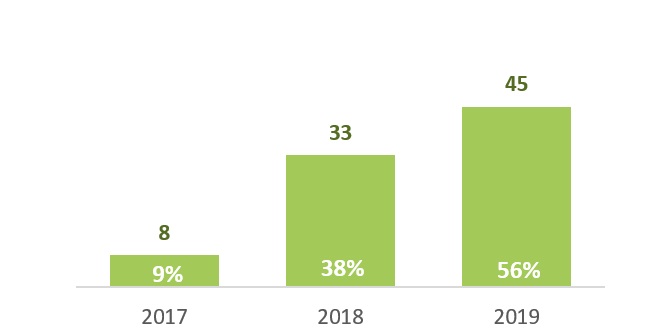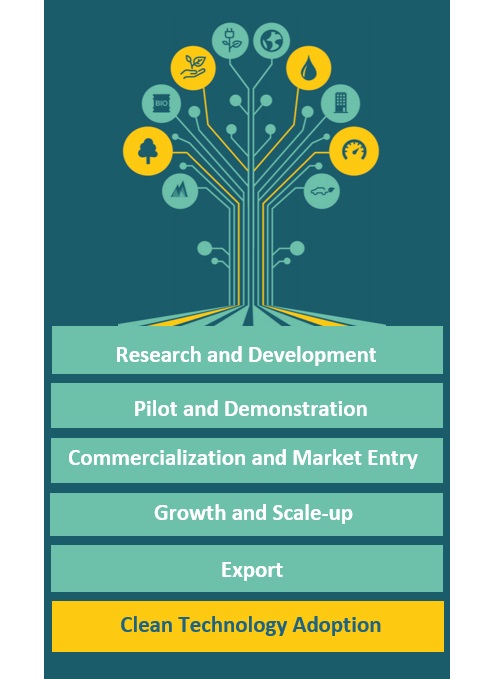Summary of the Evaluation of the Fisheries and Aquaculture Clean Technology Adoption Program (FACTAP)
About the program
The Fisheries and Aquaculture Clean Technology Adoption Program (FACTAP) contributes to the objectives and activities of DFO and the Government of Canada’s Clean Growth Hub (CGH) and Pan-Canadian Framework on Clean Growth and Climate Change (PCF). The FACTAP funds projects to implement market-ready clean technologies, processes and sustainable practices into the day-to-day operations of operators in the fisheries, aquaculture and processing sectors. The FACTAP will receive $19M over the lifespan of the program.
About the evaluation
The evaluation was conducted between January 2020 and November 2020 and examined the , performance and efficiency of the program over the three-year period from 2017-18 to 2019-20 to provide senior management with information for decision-making and to identify lessons learned and good practices that may be applied to other grant and contribution programs within DFO. Evidence was gathered through interviews, document review, literature review, a survey to recipients, and documented examples.
Key findings
The FACTAP contributes to federal and departmental priorities
The FACTAP supports the adoption of clean technology within the fisheries and aquaculture sectors, particularly among small and medium enterprises, and the number of signed contribution agreements have increased yearly, as illustrated below.

Number and proportion of signed contribution agreements, by year
Description
Bar graph depicts the number and proportion of signed contribution agreements, by year.
In 2017, 8 contribution agreements were signed (9% of all agreements).
In 2018, 33 contribution agreements were signed (38% all agreements).
In 2019, 45 contribution agreements were signed (56% all agreements).
The FACTAP has exceeded performance targets related to the number of fishing vessels as well as aquaculture and processing sites that have adopted clean technology funded by contribution agreements:
- >100% aquaculture/processing sites have adopted clean technology funded by contribution agreements (57/54 sites).
- >100% fishing vessels have adopted clean technology funded by contribution agreements (310/54 vessels).
Through the program’s current activities, the FACTAP contributes to federal and departmental priorities such as promoting clean growth, reducing greenhouse gas emissions, and addressing marine pollution. The FACTAP contributes to the:
- Pan Canadian Framework for Clean Growth and Climate Change
- Ghost Gear Reduction
- Ocean Plastics Charter
- Protection of sensitive marine areas
Support for cleantech at various stages is needed
In addition to funding the adoption of market-ready cleantech, there is a need in the fisheries and aquaculture sectors to support cleantech at other, early, stages of the Clean Growth Hub’s Innovation Spectrum. Most notably, the Research and Development, Pilot and Demonstration and Growth and Scale-up stages. The six stages of the Clean Growth Hub’s Innovation spectrum are illustrated below.

The stages of the Clean Growth Hub’s Innovation Spectrum
Description
The diagram depicts the six stages of the Clean Growth Hub’s Innovation Spectrum including research and development, pilot and demonstration, commercialization and market entry, growth and scale up, export, and clean technology adoption.
The FACTAP can achieve greater impacts at the sector level
Through the program’s current activities, the FACTAP is supporting improvements in the environmental performance of the recipients it funds. For example, by reducing energy consumption and greenhouse gas (GHG) emissions, as listed below.
- 78% of respondents reported reduced energy consumption
- 48% of respondents reported reduced GHG emissions
- 30% of respondents reported improved waste management
- 26% of respondents reported reduced water use
- 19% of respondents reported reduced plastic use
- 19% of respondents reported reduced chemical use
Generating broader adoption and improvements in environmental performance among operators at the sector-level remains a challenge. Operators lack knowledge of available cleantech and of funding opportunities. Also, the FACTAP largely funds projects that are less than $100,000 which limits the program’s impact at the sector level. The FACTAP can engage in a proactive and strategic funding approach to increase the program’s impact on operators’ environmental performance.
There are factors that limit the FACTAP’s ability to generate program awareness
Overall, the FACTAP is administered efficiently. Nevertheless, FACTAP regional program coordinators face a significant administrative workload due to the effort required to see applicants through the project application, evaluation of proposals, establishment of contribution agreements, distribution of funds, and reporting processes. This is particularly true given the size of FACTAP’s administrative regions and the limited technical capacity of applicants to fulfill application and reporting requirements, such as proposals. The diagram below illustrates the full-time equivalents (FTEs) by administrative region of the FACTAP.

FACTAP FTEs by administrative region
Description
The figure displays a map of Canada depicting the FACTAP’s Pacific, Central & Arctic, and Atlantic administrative regions. The map also depicts the number of FTE’s per region. There is one FTE in each administration region, as well as two FTE’s in the program’s national headquarters.
As a result, program promotion is not a priority for regional program coordinators and this contributes to a low awareness of the program among operators. FACTAP recipients learn about the program through various channels:
- 50% of survey respondents learnt about the FACTAP through Industry associations;
- 27% of survey respondents learnt about the FACTAP through conference events;
- 23% of survey respondents learnt about the FACTAP through word-of-mouth;
- 20% of survey respondents learnt about the FACTAP through DFO’s notice to fishers;
- 10% of survey respondents learnt about the FACTAP through the FACTAP website; and
- 0% of survey respondents learnt about the FACTAP through the CGH website.
Recommendations
Under its current mandate and design, the FACTAP performs well. However, FACTAP regional program coordinators face administrative workload that limits the ability of the program to pursue improvements that might generate broader adoption and improvements in environmental performance within the fisheries and aquaculture sectors.
- Strategic funding: The Senior Assistant Deputy Minister, Strategic Policy work with fisheries, aquaculture and processing operators and associations to adopt a more proactive and targeted approach to address key environmental issues associated with these industries thus increasing the overall impact and reach of the Program.
- Eligible activities: The Senior Assistant Deputy Minister, Strategic Policy, consider expanding the range of eligible FACTAP activities to include additional stages of the cleantech Innovation Spectrum beyond funding of market-ready technologies.
- FACTAP promotion: The Senior Assistant Deputy Minister, Strategic Policy, engage in additional promotional activities for the FACTAP including direct outreach activities to potential recipients of the program and collaboration with industry associations.
- Date modified: